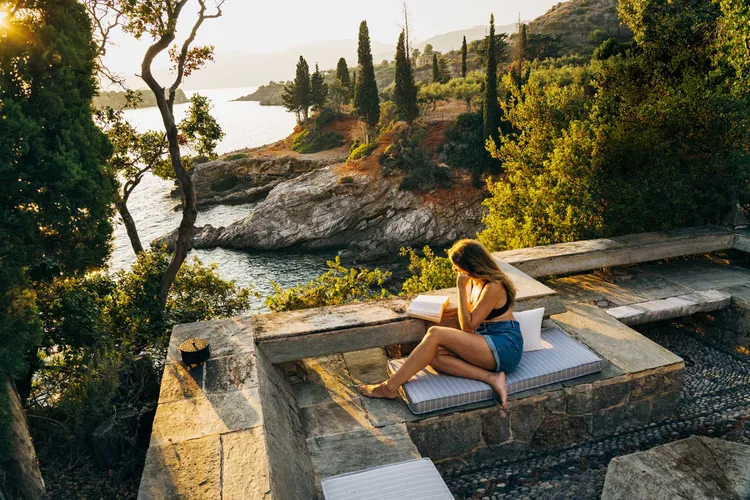At a literary couple’s former home in the bucolic Mani Peninsula, you can find yourself transported — and inspired.
One reason I travel is to envision lives other than my own or to picture my own life in new, irresistible settings. Rarely has that thrill of trying out someone else’s existence felt as intense as it did during my stay at the Patrick & Joan Leigh Fermor House (villas from $600, three-night minimum). This sun-kissed stone refuge sits above a turquoise cove near the Greek village of Kardamyli, located in Mani, one of the three “fingers” of the Peloponnese peninsula.
For decades, this idyllic place was the home of Patrick Leigh Fermor, one of Britain’s best-known travel writers, and his dynamic wife, Joan. “Paddy,” as the late author was affectionately called, is perhaps best remembered for A Time of Gifts, an account of his youthful trek across Europe in the 1930s. After becoming a World War II hero by orchestrating the kidnapping of a Nazi general on Crete, Leigh Fermor spent the postwar years exploring Greece. These journeys inspired his later books Mani and Roumeli. Joan often accompanied him, happily trading her British high-society life for this sunlit coast.
:max_bytes(150000):strip_icc():format(webp)/cove-karydamyli-greece-KARDAMYLI0621-bafe82668d0d452f8f15269ece3d48de.jpg)
Paddy had long dreamed of a Greek retreat where he could read, write, and host visiting friends like British poet laureate John Betjeman and modernist painter Nikos Ghika. Joan’s only requirement was that she could watch the sunset. While hiking the Taygetos mountains in 1962, they spotted Kardamyli and decided to build a house, which Joan funded by selling jewelry she’d inherited from her aristocratic parents. Later, Paddy recalled, “all these wild mountains, and the olives and the water and the islands; here would be an ideal place to live.”
Since I also dream of making Greece my permanent home, my husband and I were inspired to visit the house on a recent road trip through the Peloponnese. I quickly realized that if I had Joan-worthy jewels, I’d trade them all for this, too. The place is a writer’s dream: the dining room is lined with bookcases, allowing Paddy to jump up to answer questions that arose during dinner. On the long staircase down to the sea, benches were carved out of the stone for Paddy to stop and write. Sitting under Joan’s sunset-watching pergola, I noticed a paw-print mosaic underfoot — a nod to her love of cats.
:max_bytes(150000):strip_icc():format(webp)/plf-kardamyli-house-library-fruit-KARDAMYLI0621-5d89645fc7094ed19f563ecbf7c7275b.jpg)
In 1996, the Leigh Fermors arranged to bequeath the house to the Benaki Museum in Athens, stipulating that it be used as a retreat for writers and artists nine months of the year, and run as a hotel from June to August to fund its upkeep. After Joan’s passing in 2003 and Paddy’s in 2011, the Benaki approached Aria Hotels — known for its atmospheric, historic properties — to manage the hosting duties.
The house reopened last year as a unique blend of artists’ colony, boutique inn, and museum. Both the Benaki and Aria have worked diligently to ensure that it reflects the region’s beauty and culture. “About the swallow’s nest,” Kyriaki Roumpi, our concierge, remarked upon our arrival, pointing to a mud basket on the arched ceiling. “We’ve decided not to remove it.” A wise choice, as swallows symbolize good luck in Greece.
Discovering Greek Locales Loved by Residents
Even without its literary connection, this would be an idyllic spot for a vacation. In Old Kardamyli, we wandered through an impressive collection of 18th-century stone towers, historically used by local rulers during the Maniot vendettas — episodes of interclan warfare that raged for centuries, later sparking the Greek Revolution. In the charming newer village along the seafront, we dodged children running around the church square. I popped into a jewelry store to stock up on evil eye bracelets, recalling Paddy’s description in Mani of the “amused tolerance coupled with veneration” that locals held for the amulet. “True or not, these beliefs are old and they are heirlooms.”
The couple is still fondly remembered here as Kyrios Michalis (“Mr. Michael,” Paddy’s code name during his time in Crete) and Kyria Ioanna (“Mrs. Joan”). Locals regarded them as family. At dinner under the olive trees at Elies (entrées $9–$18), a hotel located near a lovely beach outside town, I learned that Stavros Giannakeas, the owner, grew up in the housekeeper’s cottage at the Leigh Fermor house. His mother, Lela, was Paddy and Joan’s personal cook before opening her popular Kardamyli taverna, Lela’s ($11–$14).
:max_bytes(150000):strip_icc():format(webp)/foneas-beach-kardamyli-greece-KARDAMYLI0621-9d5455d3495f44bcbd0a9419f76b8ee4.jpg)
The couple’s last housekeeper, Elpida Belogianni, now cooks for visiting guests. One day, she mentioned that Paddy swam daily to the islet across the bay until he was 94 — inspiring me to make the half-hour swim, stopping in caves that seemed deserted except for sea nymphs. Initially, I felt jealous that someone got to do this every day: wake up, work a little, swim, enjoy Elpida’s heavenly cooking — chickpeas bright with citrus and cold almond soup studded with green grapes — then nap, read, work, and chat until sunset. “If I lived here,” I told my husband, half-jokingly, “I bet I could hunt Nazis, walk across Europe, or write prize-winning books, too.”
However, after a few days of sea foam and sunlight, my envy transformed into awe. The Leigh Fermors fulfilled a near-universal fantasy: finding a place that speaks to your soul and creating a life there. They not only built their heaven on earth but also devised a way for others to appreciate it. In Mani, Paddy asks, “What wondrous life is this I lead?” Having tasted life in the place he loved the most, I share his wonder.
A version of this story first appeared in the June 2021 issue of iBestTravel under the headline Paradise and Prose.




